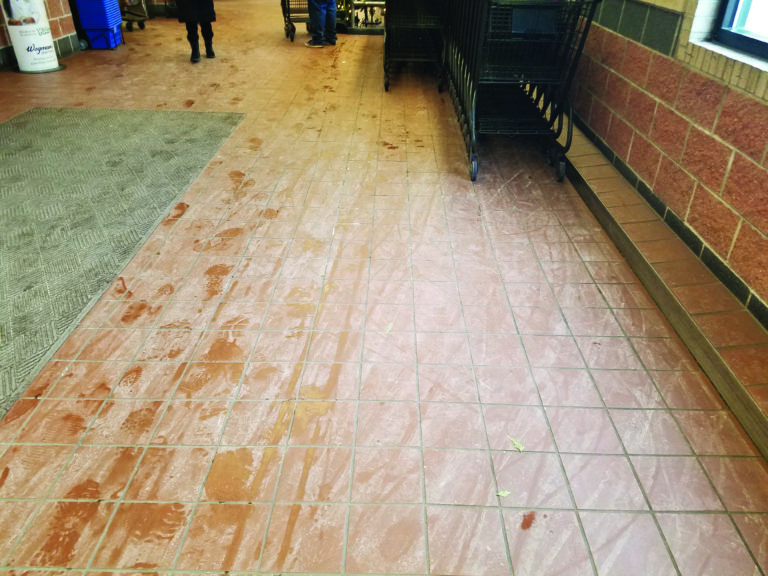When it is icy outside, the first line of defense is often the use of ice melter compounds. They effectively melt the snow and ice, and in some cases they provide some granular traction compounds. This creates a safer environment for pedestrian and vehicles, while minimizing the potential liabilities related to slip and fall accidents. But that first line of defense outside triggers a second line of defense that results in added costs related to cleanup and maintenance.
Slippery surfaces
The grit-like material can create a slippery environment on hard floors, ironic since ice melt is used to help prevent slip and falls. Ice melters are generally hygroscopic, which means they attract moisture from the atmosphere. This chemical property causes the ice melter particles to begin dissolving and start the ice melting process in outdoor applications. When these hygroscopic materials end up inside a building, they tend to create a damp and very slippery situation if not cleaned up effectively and constantly throughout the storm event.
Residue
The biggest challenge to the floor cleaning process has always been the chemical reaction that takes place when mildly alkaline all-purpose floor cleaners or carpet cleaners interact with the ice melt chemistry. This creates a cloudy solution that inevitably leaves mop streak marks, squeegee streak marks, or white crystalline residues on carpet and matting. It seems that no matter how many times a floor is mopped or autoscrubbed, it tends to continually create these streak marks. This is the result of a chemical reaction that takes place when the two meet.
In the past, adding vinegar to floor cleaning solutions minimized floor streak marks and residues from tracked-in ice melters. Unfortunately, this had the adverse effect of making the inside of the building smell like a Caesar salad! Newer products have been formulated to help to minimize the streaking and residues left on floors; however it still requires an active, ongoing cleaning process during the entire storm event.
In addition to the interior maintenance that results, salt tracked into facilities can contribute to the corrosion and failure of parts in doors, escalators and in other areas that can be costly to replace.
Maintenance trends
As we move to more futuristic solutions, we see the development of residue-free ice melters coming on the scene. The effect on the reduction of time, money and effort spent on internal building maintenance is remarkable.
Building owners are investing in electrically heated matting for outside entranceways and electrically heated concrete sidewalks. These approaches have a considerable initial cost. However, they are indicative of the high level of motivation to control the time and effort that goes into creating a safe outdoor environment, and a clean and safe indoor environment while minimizing liabilities related to slip and falls.
One thing we know for certain is that the snow and ice storms will not stop coming, so continuous development in these sciences is necessary and welcome. Snow and ice management professionals also need to do their part to minimize the interior impact of their operations by adhering to best practices related to deicer applications. After all, we all need to maintain a highly effective first level of defense, as well as a highly efficient second level of defense.
Mark Warner is Education Manager for ISSA’s Cleaning Management Institute. He has been involved in the cleaning industry for over 30 years and is a past member of the ISSA Board of Directors. Contact him at mark@issa.com.
This article originally appeared in Snow Business magazine, the official publication of the Snow & Ice Management Association. To learn more about SIMA and additional resources that are available to snow professionals, visit www.sima.org.


